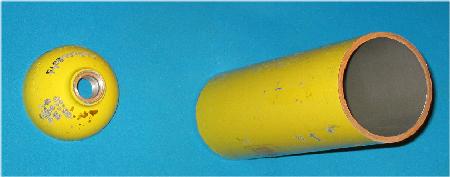
An Aluminum Alloy 6531 Cylinder Crack
by
Larry "Harris" Taylor, Ph.D.
This material is copyrighted and the author retains all rights. This article is made available as a service to the diving community by the author and may be distributed for any non-commercial or Not-For-Profit use.
All rights reserved.
Go To: Home About "Harris" Articles Slides War Stories Editorials Links Fini
There have been catastrophic failures in aluminum scuba cylinders manufactured with aluminum alloy 6531. These cylinders were manufactured in the United States by a variety of manufacturers from 1971 to 1988.
This problem began in 1983 when failures in hoop wrapped cylinders resulted in fatalities. Initial investigation of these failures suggested 4 possible explanations:
a. cracking occurred exclusively at the neck ... the region of highest residual stress associated with manufacturing
b. some cylinders had folds in the neck region
c. the aluminum had high levels (> 100 ppm) of lead
d. recycled scrap had been used in their manufacture
In general, the first item above is relevant to scuba cylinders.
The cracks in 6531 alloy cylinders primarily occur in the neck region (figure below) where the crown (threaded portion) meets the body of the cylinder. This volume of the cylinder has the highest residual metallurgical stress from the manufacturing process. This suggests that the cracks are a result of residual stress associated with manufacturing and not exclusively a result of excessive internal gas pressure or poor design. Briefly, the cracks extend from notches created when the cylinder neck is made. Over time, the point of notch formation extends and forms cracks. Crack formation is driven by the combination of applied pressure from gas contents acting on regions of residual stress from the manufacturing process. This process, termed Sustained Load Cracking (SLC) takes many years to create a crack large enough to effect cylinder integrity. Thus far, the cracks have been limited exclusively to the 6531 alloy.

As a result of crack appearances in numerous aluminum cylinders and some catastrophic failures, scuba manufacturers switched alloys used to manufacture scuba cylinders in the late 1980's from aluminum alloy 6531 to aluminum alloy 6061. Luxfer claims that the 6061 alloy is not subject to SLC, but some metallurgists dispute this claim.
In 1999, both the US Department of Transportation (DOT) and the National Institute for Industrial Safety and Health (NIOSH) expressed concerns over aluminum cylinders used in scuba diving. While many cylinders will show cracking in the thread region (easily seen by a skilled visual inspector using appropriate lighting), some cylinders apparently develop internal cracking in the neck/crown region of the cylinder that cannot be seen by visual inspection. So, it cannot be assumed that all cylinders will show cracks in the thread region or leak prior to catastrophic failure.
Since these cracks take many years to develop, the best strategy to prevent explosive cylinder failure is a a combination of hydrostatic testing, visual inspection (with particular attention to the threads), and so called eddy-current testing. Eddy current testing uses electromagnetic induction to create an electrical current within the metal being tested. Anomalies in the metal structure (like internal cracks from SLC) will alter the circular path (an eddy current) of the induced current. These alterations can be detected by a skilled tester. It is particularly important that the eddy current technician be properly trained. (Manufacturers report a large number of eddy-current condemned cylinders had no flaws).
My Experience
Below are images of a Luxfer aluminum 6531 alloy 14 ft3 cylinder ("pony bottle") purchased in October of 1982. After years of sitting unused on a shelf, an attempt was made in 2009 to return the cylinder to service. Although the cylinder failed my visual inspection, out of curiosity, I submitted it to a new (for me) hydrostatic tester. The cylinder failed hydrostatic testing. Examination of the neck region revealed Sustained Load Cracking. The neck region (magnified 20 x using a hand held digital Microscope by Celestron) is shown below:

This crack extended through the neck region to the outside of the cylinder. The outside of the cylinder is shown below:
 |
 |
| 20 x | 400x |
Finally, scuba gear is never discarded ... scuba stuff removed from service simply becomes a training aid.

Further Reading
High, Bill, Cracking and Ruptures of SCBA and SCUBA Aluminum Cylinders Made from 6351 Alloy (available from psi)
Price, JWH & Ibrahim, RN. Cracking in Aluminum Gas Cylinders: A Review of Causes & Protection Measures, Practical Failure Analysis, 3(6), 2003, 47-55.
Acknowledgements
Hydrostatic Testing & Welding, Inc. Lambertville, Michigan
Go To: Home About "Harris" Articles Slides War Stories Editorials Links Fini
About the Author:
Larry "Harris" Taylor, Ph.D. is a biochemist and Diving Safety Coordinator at the University of Michigan. He has authored more than
200 scuba related articles. His personal dive library (See Alert Diver, Mar/Apr. 1997, p. 54) is considered by one of the best sources of information in North America.
All rights reserved.
Use of these articles for personal or organizational profit is specifically denied.
These articles may be used for not-for-profit diving education